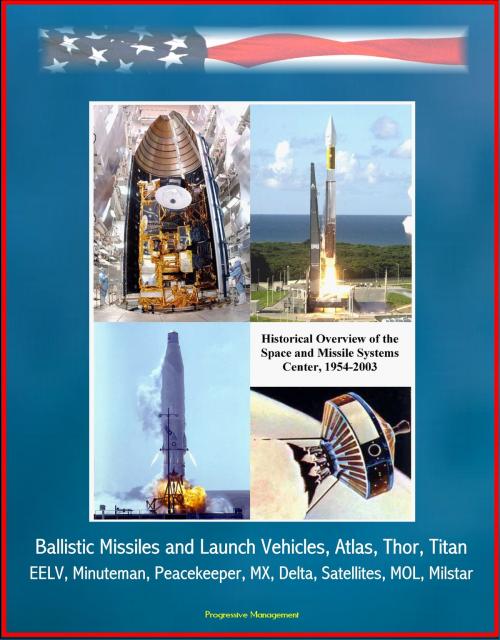Historical Overview of the Space and Missile Systems Center 1954-2003: Ballistic Missiles and Launch Vehicles, Atlas, Thor, Titan, EELV, Minuteman, Peacekeeper, MX, Delta, Satellites, MOL, Milstar
Nonfiction, Science & Nature, Technology, Aeronautics & Astronautics, History, Military, Aviation| Author: | Progressive Management | ISBN: | 9781311159748 |
| Publisher: | Progressive Management | Publication: | April 2, 2015 |
| Imprint: | Smashwords Edition | Language: | English |
| Author: | Progressive Management |
| ISBN: | 9781311159748 |
| Publisher: | Progressive Management |
| Publication: | April 2, 2015 |
| Imprint: | Smashwords Edition |
| Language: | English |
Professionally converted for accurate flowing-text e-book format reproduction, this publication provides a historical overview of the Space and Missile Systems Center and its antecedents during approximately the first 50 years of their existence. The Center's organizational ancestors include the Western Development Division and the Air Force Ballistic Missile Division of the 1950s, Space Systems Division and Ballistic Systems Division of the 1960s, the Space and Missile Systems Organization of the 1960s and 1970s, and Space Division and the Ballistic Missile Office of the 1980s. This history describes the evolution of their mission and organizational structure, the history of base facilities, and the history of the principal space and missile programs managed by SMC and its predecessors. Although this essay touches on a few space programs managed by other agencies, its focus is institutional: it is about the work and infrastructure of SMC rather than other organizations, however worthy.
Chapter I: Mission and Organization * Chapter II: Facilities * Chapter III: Ballistic Missiles * Chapter IV: Launch Vehicles * Chapter V: Satellite Systems * Chapter VI: Air Force Satellite Control Network * Chapter VII: Other Programs * Chapter VIII: Increasing Reliance on Space Systems in Combat
SMC and its predecessors have been supported over the years by private sector organizations that have provided systems engineering for its programs and technical direction to its contractors. The first such organization was the Ramo-Wooldridge Corporation, chosen in 1954 to provide systems engineering and technical direction for WDD's missile programs. In 1958, Ramo-Wooldridge merged with Thompson Products to form Thompson-Ramo-Wooldridge (TRW). However, Congress expressed reservations about the propriety of a profit-making entity serving an agency of the government so closely and exclusively. In 1959, Congress recommended that a nonprofit agency be established as the systems engineering arm of the Air Force for space and missile programs. In June 1960, a nonprofit organization—The Aerospace Corporation—was created at the initiative of the Secretary of the Air Force to perform that function. At that time, plans called for TRW to continue providing systems engineering for existing missile programs and for Aerospace to provide systems engineering for all space programs and for future missile programs. As it turned out, Aerospace did perform some work in the missile field, but it focused primarily on space, and TRW remained the primary source of systems engineering for missile programs.
Professionally converted for accurate flowing-text e-book format reproduction, this publication provides a historical overview of the Space and Missile Systems Center and its antecedents during approximately the first 50 years of their existence. The Center's organizational ancestors include the Western Development Division and the Air Force Ballistic Missile Division of the 1950s, Space Systems Division and Ballistic Systems Division of the 1960s, the Space and Missile Systems Organization of the 1960s and 1970s, and Space Division and the Ballistic Missile Office of the 1980s. This history describes the evolution of their mission and organizational structure, the history of base facilities, and the history of the principal space and missile programs managed by SMC and its predecessors. Although this essay touches on a few space programs managed by other agencies, its focus is institutional: it is about the work and infrastructure of SMC rather than other organizations, however worthy.
Chapter I: Mission and Organization * Chapter II: Facilities * Chapter III: Ballistic Missiles * Chapter IV: Launch Vehicles * Chapter V: Satellite Systems * Chapter VI: Air Force Satellite Control Network * Chapter VII: Other Programs * Chapter VIII: Increasing Reliance on Space Systems in Combat
SMC and its predecessors have been supported over the years by private sector organizations that have provided systems engineering for its programs and technical direction to its contractors. The first such organization was the Ramo-Wooldridge Corporation, chosen in 1954 to provide systems engineering and technical direction for WDD's missile programs. In 1958, Ramo-Wooldridge merged with Thompson Products to form Thompson-Ramo-Wooldridge (TRW). However, Congress expressed reservations about the propriety of a profit-making entity serving an agency of the government so closely and exclusively. In 1959, Congress recommended that a nonprofit agency be established as the systems engineering arm of the Air Force for space and missile programs. In June 1960, a nonprofit organization—The Aerospace Corporation—was created at the initiative of the Secretary of the Air Force to perform that function. At that time, plans called for TRW to continue providing systems engineering for existing missile programs and for Aerospace to provide systems engineering for all space programs and for future missile programs. As it turned out, Aerospace did perform some work in the missile field, but it focused primarily on space, and TRW remained the primary source of systems engineering for missile programs.















